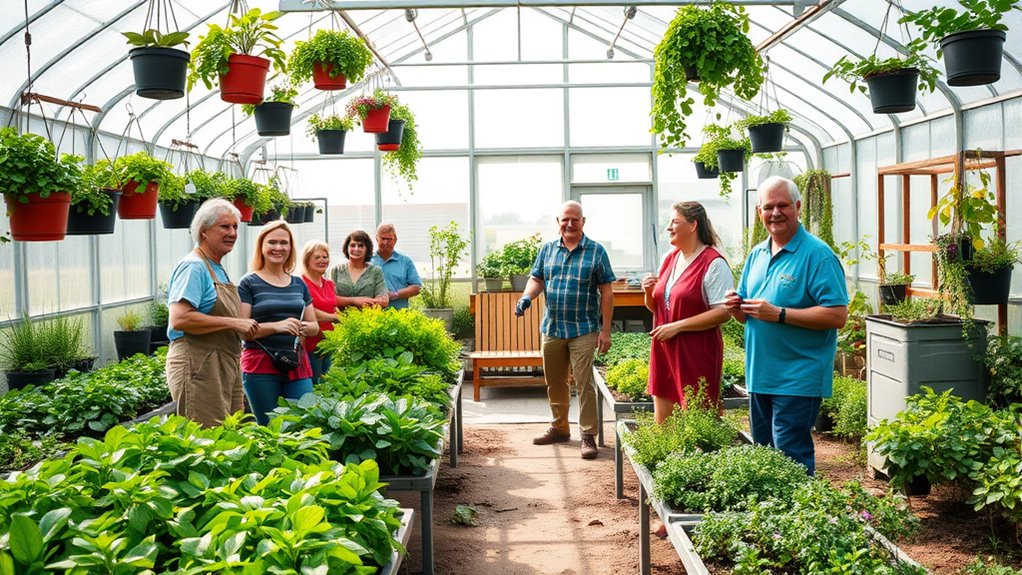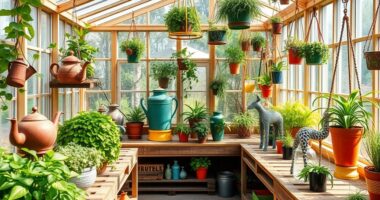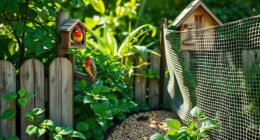To connect with fellow gardeners in greenhouse communities, join local or online groups focused on sustainable gardening. Share your experiences, composting techniques, and pest management tips to build a supportive network. Participating in community projects or workshops can boost your skills and motivation. These collaborations foster collective growth and resilience. If you want to learn more about building strong greenhouse communities and sustainable practices, keep exploring how to create meaningful connections with others who share your interest.
Key Takeaways
- Join local greenhouse or community garden groups to share experiences and resources.
- Participate in community events, workshops, or online forums focused on sustainable gardening.
- Collaborate with neighbors on composting, pest management, and planting projects for collective benefits.
- Use social media platforms to connect, exchange tips, and organize garden-related activities.
- Establish shared responsibilities and communication channels to foster ongoing support among gardeners.

Greenhouse communities are innovative living spaces designed to blend sustainability with community engagement. When you become part of such a community, you’re stepping into a collaborative environment where sharing knowledge and resources enhances everyone’s gardening experience. A key aspect of thriving in this setting involves mastering composting techniques. Composting not only reduces waste but also provides nutrient-rich soil for your plants. You might start by collecting kitchen scraps like vegetable peels and coffee grounds, then layering them with yard waste such as leaves or grass clippings. Turning your compost regularly ensures good aeration, which speeds up decomposition and prevents foul odors. Many greenhouse communities encourage communal compost bins, where members contribute and share the resulting compost, fostering a sense of collective responsibility and sustainability. This shared approach makes it easier to maintain healthy soil, which directly benefits your plants and those of your neighbors. Developing resilience through consistent composting routines can also help you recover quickly from gardening setbacks.
Alongside composting, pest management plays a pivotal role in maintaining a healthy greenhouse environment. You’ll want to learn integrated pest management (IPM) strategies to keep pests at bay without relying heavily on chemicals. Start by regularly inspecting your plants for signs of pests or disease. Introducing natural predators, such as ladybugs or beneficial nematodes, can help control common pests like aphids or spider mites. Companion planting is another effective method; for example, planting marigolds near vegetables can deter nematodes and aphids. You’ll also want to maintain good hygiene within the greenhouse—removing diseased or dead plant material prevents pest infestations from spreading. Use physical barriers like insect netting or row covers to protect vulnerable plants during peak pest activity. When pest issues do arise, opt for eco-friendly solutions, such as neem oil or insecticidal soaps, which are safer for both your plants and the environment. Sharing pest management tips within your community encourages a collective effort, reducing the likelihood of large infestations and promoting healthy, productive gardens. Building resilience through adaptive strategies enables your community to better withstand environmental challenges.
Living in a greenhouse community means you’re never alone in facing challenges or celebrating successes. By exchanging composting techniques and pest management strategies, you build a knowledge base that benefits everyone. This collaborative approach not only improves your gardening skills but also strengthens your connection with fellow gardeners. You learn from their experiences, troubleshoot problems together, and enjoy the shared satisfaction of growing healthy plants in a sustainable way. Ultimately, connecting with others in your greenhouse community transforms gardening from a solitary task into a rewarding social activity, deepening your appreciation for sustainable living and collective growth.
Frequently Asked Questions
How Do I Join a Greenhouse Community Near Me?
To join a greenhouse community near you, start by searching online or visiting local community centers and garden stores. Many groups organize seed exchanges and gardening workshops that welcome new members. Attend these events to meet fellow gardeners, learn tips, and get involved. You can also join social media groups or local gardening clubs to stay updated on upcoming activities and connect with others passionate about gardening.
What Are Common Activities in Greenhouse Communities?
Imagine your greenhouse as a thriving symphony, where each activity plays a essential role. You’ll often engage in companion planting, pairing plants for mutual benefit, and collaborate on pest management strategies to keep pests at bay. Community members share tips, swap seedlings, and work together to maintain healthy, productive environments. These activities foster teamwork and learning, making your gardening journey more enjoyable and successful.
How Can I Start a Greenhouse Community if None Exists Locally?
To start a greenhouse community, begin with community planning by identifying local gardening enthusiasts interested in shared space. Reach out through social media, local clubs, or community centers to build awareness. Highlight membership benefits like access to tools, shared knowledge, and seasonal workshops. Organize initial meetings to set goals, rules, and schedules. With clear planning and engaging members, you’ll create a thriving, collaborative greenhouse community that benefits everyone involved.
What Tools or Resources Are Shared Within These Communities?
In greenhouse communities, members often share tools like seed swapping kits and gardening workshops to foster collaboration. You might find seed exchanges, where you trade seeds with fellow gardeners, and attend workshops to learn new techniques. These resources help you grow your skills and expand your garden’s diversity. Sharing tools and knowledge builds a supportive environment, making gardening more enjoyable and successful for everyone involved.
How Do Greenhouse Communities Support Sustainable Gardening Practices?
Imagine chatting with fellow gardeners in a virtual space, like an early 21st-century chatroom. Greenhouse communities support sustainable gardening by sharing composting techniques that enrich soil naturally and pest management strategies that minimize chemical use. You learn from others’ experiences, exchange eco-friendly tips, and stay updated on sustainable methods. This collaboration helps you reduce environmental impact, promotes organic growth, and fosters a community committed to eco-conscious gardening.
Conclusion
Just like a greenhouse nurtures delicate plants, connecting with fellow gardeners helps your community thrive. Sharing tips, stories, and encouragement creates a vibrant space where everyone grows stronger together. So, don’t be shy—reach out, join local groups, or start your own. Remember, a community is like a well-tended garden: it flourishes when everyone tends to it with care and passion. Your green thumb can inspire others, turning your garden into a lush, supportive oasis.









